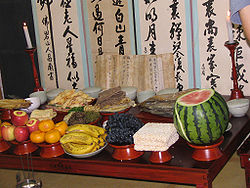- Chuseok
-
Chuseok 
Jesasang, ceremonial table setting on Chuseok.Official name Chuseok (추석, 秋夕) Also called Hangawi (한가위) Observed by Koreans Type Cultural Significance Celebrates the end of the fall harvest season Date 15th day of the 8th lunar month 2010 date 22 September 2011 date 12 September 2012 date 30 September Observances Visit to hometowns, ancestor worship, harvest feasts with songpyeon and rice wines Related to Mid-Autumn Festival Chuseok Hangul 추석 Hanja 秋夕 Revised Romanization Chuseok McCune–Reischauer Ch'usŏk Chuseok (Korean: 추석), originally known as Hangawi (한가위, from archaic Korean for "the time of Autumn"), is a major harvest festival and a three-day holiday in Korea celebrated on the 15th day of the 8th month of the lunar calendar. Like many other harvest festivals, it is held around the Autumn Equinox. As a celebration of the good harvest, Koreans visit their ancestral hometowns and share a feast of Korean traditional food such as songpyeon and rice wines such as sindoju and dongdongju.
Contents
Origins
Historically and according to popular belief, Chuseok originates from Gabae. Gabae started during the reign of the third king of the kingdom of Silla (57 BC - AD 935), when it was a month-long weaving contest between two teams.[1][2] Come the day of Gabae, the team that had woven more cloth had won and was treated to a feast by the losing team. However, it is also said that Chuseok marks the day Silla won a great victory over the rival kingdom of Balhae. It is believed that weaving competitions, archery competitions, and martial arts demonstrations were held as part of the festivities.[3]
Many scholars also believe Chuseok may originate from ancient shamanistic celebrations of the harvest moon.[4] New harvests are offered to local deities and ancestors, which means Chuseok may have originated as a worship ritual.[5] In some areas, if there is no harvest, worship rituals are postponed, or in areas with no annual harvest, Chuseok is not celebrated.
Traditional customs
In modern South Korea, on Chuseok there is a mass exodus of Koreans as they return to their hometowns to pay respects to the spirits of their ancestors. People perform ancestral worship rituals early in the morning. They often visit the tombs of their immediate ancestors to trim plants and clean the area around the tomb, and offer food, drink, and crops to their ancestors. Harvest crops are attributed to the blessing of ancestors.
One of the major foods prepared and eaten during the Chuseok holiday is songpyeon (송편), a crescent-shaped rice cake which is steamed upon pine needles. Other foods commonly prepared are japchae, bulgogi and fruits.
Folk games
A variety of folk games are played on Chuseok to celebrate the coming of Autumn and rich harvest. Village folk dress themselves to look like a cow or a turtle, and go from house to house along with a Nongak band playing music. Other common folk games played on Chuseok are tug of war, archery, and ssireum (Korean wrestling). Folk games also vary from region to region. The Ganggangsullae dance, forming a circle under the moon is performed by women and children in southwestern coastal regions. They also play the Korean plank, a traditional game played by women on a wooden board.
Dates for Chuseok on the Gregorian calendar
Chuseok is on the following days:
- 2006: October 6
- 2007: September 25
- 2008: September 14
- 2009: October 3
- 2010: September 22
- 2011: September 12
- 2012: September 30
- 2013: September 19
- 2014: September 8
- 2015: September 27
- 2016: September 15
- 2017: October 4
- 2018: September 24
Chuseok, as well as the day before it and afterwards, are statutory holidays in South Korea.
Notes
- ^ The Academy of Korean Studies, ed. (1991), "Chuseok", Encyclopedia of Korean People and Culture, Woongjin (in Korean)
- ^ Farhadian, Charles E. (2007). Christian Worship Worldwide. Wm. Bm. Eerdmans Publishing. ISBN 9780802828538.
- ^ Festive occasions: the customs in Korea by Sŏ-sŏk Yun
- ^ Farhadian, Charles E. (2007). Christian Worship Worldwide. Wm. Bm. Eerdmans Publishing. ISBN 9780802828538.
- ^ Korea University Institute of Korean Culture, ed. (1982), "Social Life", Korean Heritage Overview, 1, Korea University (in Korean)
References
The Academy of Korean Studies, ed. (1991), "Chuseok", Encyclopedia of Korean People and Culture, Woongjin (in Korean)
Farhadian, Charles E. (2007). Christian Worship Worldwide. Wm. Bm. Eerdmans Publishing. ISBN 9780802828538.
Korea University Institute of Korean Culture, ed (1982). "Social Life". Korean Heritage Overview. 1. Korea University (in Korean)
The Official Site of Korean Tourism: Chuseok http://english.visitkorea.or.kr/enu/SI/SI_EN_3_6.jsp?cid=811650
See also
- Hansik, another Korean holiday for ancestral rituals
- List of harvest festivals
- Public holidays in South Korea
- List of Korea-related topics
Categories:- Holidays in Korea
- Buddhist holidays
- Autumn holidays
- Harvest festivals
Wikimedia Foundation. 2010.


